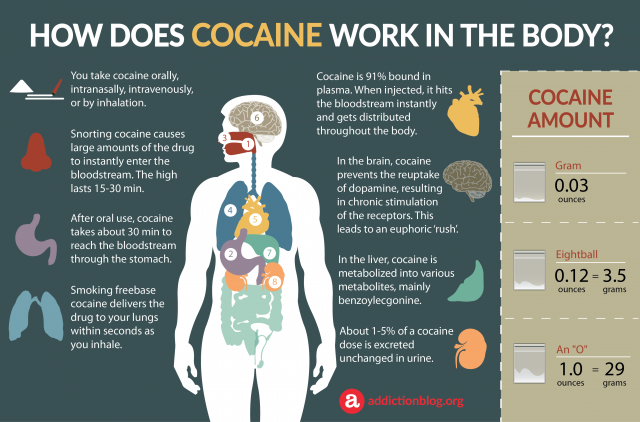Today’s High is Tomorrow’s Nightmare
Cocaine has powerful effects on the human brain. In fact, it can cause extreme euphoria. Because people know this, they easily get involved in the experience of trying it. And yes, it is true, a cocaine high can make you feel confident, alert, and awake… at least during early use initiation.
But as your brain becomes used to the presence of the chemicals found in cocaine, the other, not-so-pleasant side of cocaine can hijack your central nervous system. Besides the deeply frustrating and unsatisfying crash after the effects of cocaine wear off, your body can also suffer an incredibly negative transformation. In short, negative side effects of cocaine use can include:

- anhedonia (lost ability to feel pleasure)
- blood vessel damage
- brain aging
- cognitive impairment
- prefrontal cortex impairment
- stroke risk
In this infographic, we show how cocaine works to affect nearly every organ in your body. The harm cocaine does will make you think twice before you try it. There is an open section for questions at the end. We to your comments about cocaine effects on the brain and body.
How Does Cocaine Work In The Body?
1. YOU TAKE COCAINE: You take cocaine orally, intranasally, intravenously, or by inhalation.
2. STOMACH: Cocaine takes about 30 minutes to reach the bloodstream after oral administration. Effects and peak plasma concentrations are similar to snorted cocaine. But, subjective “highs” are greater after oral administration.
3. NOSE: Snorting cocaine causes large amounts of the drug to instantly enter the bloodstream through the nose. The high from snorting lasts about 15-30 minutes.
4. LUNGS: Smoking freebase cocaine delivers the drug to your lungs as you inhale. Then, it is absorbed into the bloodstream and reaches the brain more quickly compared to snorting.
5. HEART: Cocaine is 91% bound in plasma. When taken by injection, it hits the bloodstream instantly. Once it enters the bloodstream it travels through the circulatory system and widely distributed through body tissues.
6. BRAIN: In the brain, cocaine prevents the reuptake of dopamine by blocking the dopamine transporter, resulting in chronic stimulation of the brain’s receptors. This leads to an euphoric ‘rush’.
7. LIVER: When cocaine reaches the liver, it is metabolized into various metabolites, mainly benzoylecgonine.
8. KIDNEYS: About 1-5% of a cocaine dose is excreted unchanged in urine. Cocaine is rapidly cleared from plasma at about 20-30 mL/min/kg. The elimination half-life of cocaine averages from 1 to 1.5 hours.
TYPICAL COCAINE AMOUNTS
Gram = 0.03 oz
Eightball = 0.125 oz or 3.5 gr
An “O” = 1.0 oz or 28.3 gr
Get Personalized Addiction Treatment Text Support
Receive 24/7 text support right away and at your convenience. There is no obligation to enter treatment and you can opt out at any time.
Want to get help, but not ready to talk? Instead, sign up for text support to receive:
- Resources about addiction and recovery
- Information about our treatment process
Got Any Questions?
Hopefully, we’ve given you a good idea about metabolism of cocaine. However, if you have any additional questions, please post them in the designated section at the end of the page. We look forward to answering any and all of your questions personally and promptly.








Related Posts